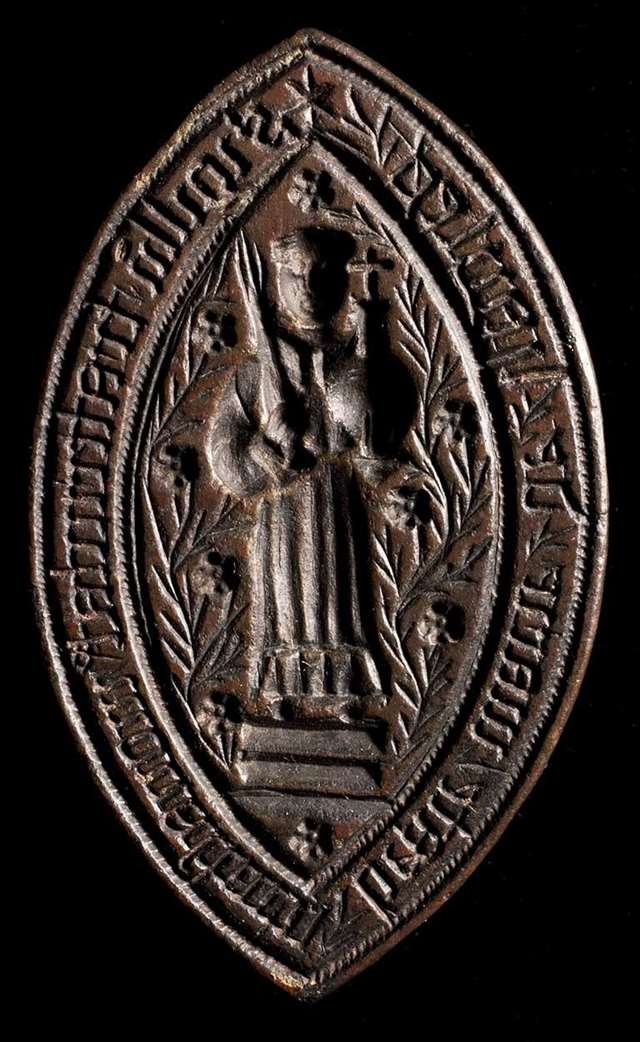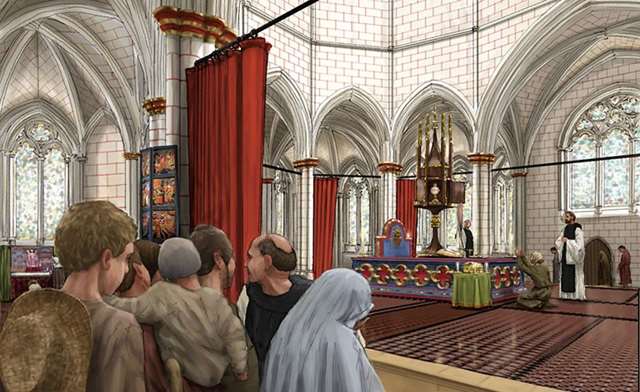

Hailes – or Hayles – Abbey was founded in 1246 by Richard Earl of Cornwall, the brother of King Henry III (who had been crowned in St Peter’s Abbey, Gloucester). Hailes Abbey Church was completed in 1251 and dedicated in November of that year. Present at this magnificent ceremony were King Henry himself, his queen, Eleanor of Provence, Earl Richard and his second wife Sanchia, sister of queen Eleanor. It is recorded that thirteen bishops said Mass, each at his own altar with Bishop Grosseteste of Lincoln, celebrating at the High Altar. Five years later – 1256 – Earl Richard was elected King of the Romans and he and his wife were crowned at Aix la Chapelle. Richard’s happiness was not to last for his wife, Queen Sanchia died in 1261 and Richard had her body brought back to England to be buried at Hailes.
A sixteenth century document, probably written by a monk of Hailes, tells how while Christ was hanging on the cross, a Jewish convert to Christianity held a small phial to Jesus side and collected some of the blood which flowed from his wounds. Other Jews, who had remained true to their faith, heard about this, reported him and caused him to be arrested. He was locked in a cell outside the city of Jerusalem where he remained for 42 years with only the phial of blood for company. One day, while the Emperors Titus and Vespasian were returning home after sacking the city of Jerusalem, they passed the small cell which housed the Jewish convert. Eager to satisfy their curiosity they made enquiries about the origins of the cell and were told the story of the Jew and the phial of blood. They ordered the cell to be unlocked and to their astonishment they found the Jew still alive and clutching the phial of blood. As the Jew refused to hand over the phial, the Emperors wrenched it from him and immediately the Jew lost both sight and speech and within a few seconds he crumbled into powder, as dead as a stone. The relic of the Holy Blood was taken to Rome, where it remained in an honoured place in the Temple of Peace, until it was captured by the Emperor Charlemagne and taken to Germany.
In the year 1267 Edmund, the second son of Earl Richard, purchased in Germany some of the Holy Blood of Jesus and gave a portion of it to his father’s foundation at Hailes. Edmund was only about seventeen at the time, and he brought the relic himself to be enshrined at Hailes in 1270 for the Festival of the Exaltation of the Cross, September 14th. He arrived at Winchcombe Abbey on 12th September and spent the night there. The following day the relic was taken to Hailes from Winchcombe amidst a long and reverent procession of monks, royal courtiers, and local spectators and pilgrims. A station was made at Rowley Meadow where the relic was welcomed by Abbot Walter and the Hailes monks. A field altar had been erected with an awning of cloth of gold over it, and on this altar the relic of the Precious Blood of Christ was placed and after a sermon had been delivered, all those present were invited to come forward on their knees to venerate the relic. When this long and moving ritual had been completed, young Edmund was handed the sacred relic, the procession reformed and continued the final stage of the journey to Hailes Abbey Church. On arrival there, the relic was offered by Edmund at the High Altar and from that day, the older shrine of St Kenelm at Winchcombe took second place to the veneration of the Precious Blood of Christ, at Hailes.
Earl Richard died shortly afterwards and was buried at Hailes, alongside his wife, Sanchia. He was succeeded by his son Edmund, who set about creating a shrine more worthy of the precious relic for which Hailes had become famous. This shrine was part of new work completed in 1277 which provided an eastern apse with five polygonal chapels, two semi circular ambulatories and a large structure some eight feet by ten, from which radiated all the rest. This structure was the base of the shrine on which rested for over 250 years, the reliquary containing the Holy Blood of Hailes. The relic was described at the Dissolution of the Monasteries as being ‘contained in a round beryl, very securely stopped and ornamented and bound with silver.’ The shrine, situated in its own chapel behind the High Altar, was dedicated by Godfrey Giffard, Bishop of Worcester in 1277 and probably resembled that of St Edward the Confessor at Westminster, St Alban at St Albans Abbey; St Birinus at Dorchester and St Egwin at Evesham, to name but a few. It would probably have been an ark like structure, with a pitched roof, and around the sides, figures of Saints set beneath ornate canopies.
In 1295, Edmund presented to the Abbey a golden cross containing a portion of the True Cross of Christ, and when he died just five years later in October 1300, his body was brought back to Hailes and buried near his parents, Richard and his queen, Sanchia. King Edward I and many bishops, knights and members of the Royal Household attended his impressive funeral.
Hailes soon became one of the most holy and revered places of pilgrimage in the county if not the country, and was visited by countless numbers of pilgrims from all over England and Wales. Chaucer’s Pardoner’s Tale has the following lines in it:
‘By God’s precious Heart and Passion, by God’s nails,And by the Blood of Christ that is in Hailes…’
and we know that Margery Kemp on her return from Compostella, travelled from Bristol, her landing port, and
‘went forth to the Blood at Hailes and there was shriven with loud cries and boisterous weeping.’
Pilgrims following the route along the Salt Way would have had a breath taking view of the monastery as they approached from the hills above it, filled at one and the same time, with excitement, reverence and awe. On arriving at the Abbey they would have probably entered by the North Transept door, passing behind the High Altar to their right and the other polygonal chapels to their left. As they neared the Chapel of the Holy Blood, and viewed the shrine in all its magnificence, candles gleaming, and offerings made by earlier pilgrims glowing in the light that streamed through the windows, their eyes must have filled with tears as they sank to their knees in deepest reverence. Their spiritual experience on this occasion would most surely have been the most memorable of their lives.
Many miracles were recorded as a result of visits to the shrine, ‘the number of which no man knoweth but God alone, for they be so renewed and increase daily’ and in 1415 the Pope gave the Abbot authority to find two confessors to hear the confessions of the many pilgrims and grant them absolution. According to Leland, ‘God sheweth daily, miracles through the virtue of the Precious Blood.’
The following four miracles were the most frequently reported:
A Lollard priest in Shropshire tried to dissuade his parishioners from making a pilgrimage to Hailes. They insisted on going, but he stayed behind to celebrate Mass. As he uncovered the chalice at Mass he saw that the wine was boiling to the brim. He repented of his decision, set off with haste and joined the pilgrimage. Another Derbyshire priest also refused to go. On opening his missal all the words were obliterated with sprinklings of blood. No matter what he did he couldn’t read the words. So barefoot and shirtless he too made the pilgrimage to Hailes.
A baker from Stone (Stow?) was selling food to pilgrims at Hailes. Not once did he or his family bother to venerate the Holy Blood. They later decided to do so, but their horse and cart bolted while they were still in the church and all their goods were destroyed. However their children were saved, so they returned once more, this time to give thanks for what they believed to have been a miracle.
Two merchants were captured at sea and imprisoned on Mont St Michel. They had a vision telling them to go to the Holy Blood. They thought it was an hallucination, but after a month they were convinced of the truth of the message, but how could they go? On Christmas Eve they were told by a voice to trust in God’s grace and when they woke, the gates of the prison were open, their chains had fallen off, and they escaped and made their pilgrimage to the Holy Blood at Hailes.
As late as 1533, Hugh Latimer wrote to Thomas Cromwell, that he dwelt within a mile of the Fosse Way at West Kineton, ‘and you would wonder how they come by flocks out of the West Country to many images, Our Lady of Worcester, but chiefly to the Blood of Hailes which they believe the very sight of it puts them in a state of salvation.’ In 1538, the Commissioners, under Hugh Latimer, now Bishop of Worcester, destroyed the shrine and took away the jewels, ornaments and money. On November 24th 1539 one month after the Abbey was surrendered, the Holy Blood of Hailes was destroyed publicly at St Paul’s Cross by John Hilsey, Bishop of Rochester. From that time on, the old saying, ‘as sure as God’s in Gloucestershire’ did not mean quite so much to pilgrims.
No Hailes pilgrim tokens have been found, but a matrix of a beautiful seal was found in 1860 in Yorkshire, with the figure of a monk holding in his right hand the phial holding the sacred blood and in the other the aspergillium with which he sprinkled with holy water the pilgrims kneeling before the shrine. It bears the legend in Latin, ‘The seal of the brothers of the monastery of the Blessed Mary at Hayles.’



No comments:
Post a Comment